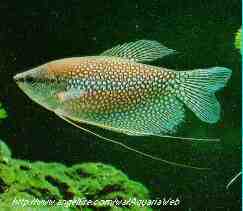

Common Name: Pearl Gourami, Mosaic Gourami, Lace Gourami, Red-Breasted
Gourami
Scientific Name: Trichogaster leeri (BLEEKER
1852)
Pronounced: Try'ko-gas"ter leer'eye
Categories: Family of the Belontiidae.
Origins: Malaysia, Sumatra, Borneo, Thailand

Description: The Pearl Gourami will slowly grow up to about 6 inches.
It's body is flattened and has both large dorsal and anal fins. The pelvic
fins are elongated into long mobile sensory filaments. They remind me of
"curb feelers". They are olive-green in color and are covered in dots of
mother-of-pearl. There is a thick dark brown line running from the snout
and narrowing at the base of the tail. After the fish are about a year old
and reach breeding age, all the colors are intensified. The male has
more red on the body and the dorsal fins are pointed with the anal fin rays
extended.
Diet: Omnivorous. Flake, frozen, live and vegetable foods.
Environment: 68-85F. with the pH between 6.5 to 8.0. A well planted
aquarium with some floating plants for them to build their bubblenests in.
A good filtration system ,but not one that would create a too strong of a
water flow and destroy the nests.
Tank Mates: Large community tank. Keep as pairs so they will display
for each other and show their true colors. They are a peaceful fish and sometimes
need protection from fast boisterous fish.
Breeding:Breeding is not very difficult. Have the water level no more
than 6 inches in depth in a tank of at least 10 gallons. Heat with a submersible
heater, or place the heater in a tall jar of water, and place it in the shallow
water. The temperature should be kept close to 80F. Keep the bottom of the
tank bare (easier to clean), however a few floating plants are an advantage.
Don't use an airstone or filter, this will break up the bubblenest.
Place the male into the tank, and the female in a small jar floating
where the male can see her. They will gradually get acquainted and after
a few hours let the female out. The courting tends to get rough, and if the
female starts to get damaged, i.e. nipped fins, remove her for her own
safety. Wait awhile and then start over. If available you might want to try
a different female. The male will then begin to build a bubblenest floating
at the surface from a sticky mucous secretion. The nest can be several inches
across and three or four bubbles deep. The male will chase the female away
while building the nest, but when he is finished he will try to coax her
beneath it.
Following a fascinating courtship ritual, the male will use his mouth
to retrieve the eggs that were released by the female. He then carries them
to the nest and places them in it. The spawning will continue until the female
is empty of eggs (up to 2000). This is the time the female should be removed
completely from the tank and given some tender care.The male will immediately
begin repairs on the nest, watch for and replace falling eggs, and guard
the nest against intruders (including the female). If the water is kept at
80F, the eggs should begin to hatch in 24 to 30 hours. After 2 or 3 days,
the yolk sacs will be absorbed and the fry will become free-swimming. The
male will become nervous, and it is best to remove him from the tank at this
time.
The fry can be fed at first on a supply of infusorians and rotifers.
If infusoria is not available, finely crushed dried foods can be used as
a substitute. Also, the yolk of a hard boiled egg squeezed through a cloth
beneath the water surface can be used. After the fry have grown some (5-6
days), they can be fed newly hatched brine shrimp
(Artemia) or Cyclops larvae.